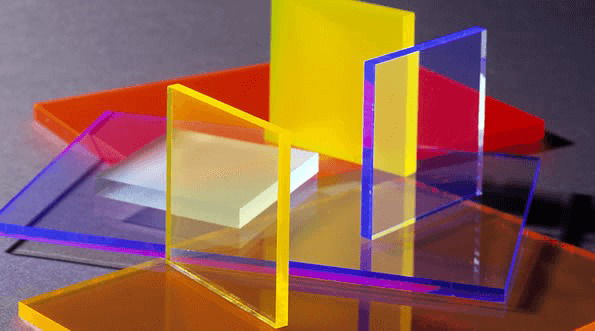Acrylic vs Polycarbonate

Acrylic and polycarbonate are two of the most popular choices of clear plastics. They provide different benefits and different drawbacks. To put it briefly the benefits and drawbacks are as followed:
Acrylic - stiffer, shinier, more scratch resistant and cheaper than polycarbonate but it can crack and shatter under impact.
Polycarbonate – more flexible and virtually unbreakable but is easier to scratch.
For a more in depth comparison it helps to consider any criteria to your needs. Here are some of the key areas to compare when choosing between acrylic and polycarbonate for your projects. We hope it helps – if you need more advice drop our friendly team a call at 866-836-3904.
Strength – which is strongest?
Acrylic and Polycarbonate are both half the weight of a comparably sized piece of glass and yet both plastics are much stronger and resistant to damage than glass. Polycarbonate, overall, is stronger than acrylic.
In comparison to glass, acrylic has 10 times the impact resistance of glass. Polycarbonate has 250 times the impact resistance of glass.
Acrylic is very rigid whereas polycarbonate can be bought in flexible grades. Acrylic cracks more easily than polycarbonate under stress.
Light – which has better clarity?
Acrylic offers better clarity than glass, letting in more light with a light transmittance of 92% compared to polycarbonate which has a light transmittance of 88%. Both are used successfully for glazing – for example, polycarbonate is often used in window replacements as it is so strong. Both acrylic and polycarbonate are used for secondary glazing.
Acrylic can be polished to restore its clarity. Polycarbonate cannot be polished.
Working with Acrylic & Polycarbonate
Acrylic can be used at temperatures ranging from -30 degrees Fahrenheit to 190 degrees Fahrenheit. It may expand and contract with changes in temperature although it won’t permanently shrink over time.
Polycarbonate can handle temperatures up to 240 degrees Fahrenheit. Polycarbonate is also resistant to chemicals such as gasoline and acids.
Which is easier to cut?
Both acrylic and polycarbonate can be cut with conventional tools such as saws or routers, though acrylic is easier to cut than polycarbonate.
Polycarbonate is a bit more stubborn when cut with a saw or router at the start.
Which is easier to drill?
Acrylic will crack if it is drilled near an edge or with a drill bit not designed for plastic. Polycarbonate typically does not crack when being drilled even if drilled close to the edge with a standard drill bit.
Which polishes up better?
The edges of acrylic can be polished smooth and shiney. Polycarbonate cannot be polished.
Which is easier to bend?
Heat bending works better with acrylic than polycarbonate. Polycarbonate however can be cold formed or bent without heating.
Which is easier to glue?
Gluing with cements designed for acrylic and polycarbonate work well. Acrylic gives a cleaner glue joint than polycarbonate.
Which is easier to keep clean?
Both acrylic and polycarbonate are easy to clean. The best choice for cleaning is a micro fibre or 100% cotton cloth only.
Acrylic should only be cleaned with warm soap water or an acrylic cleaner. Chemicals should never be used on acrylic.
Polycarbonate has a higher chemical resistance than acrylic; it can be cleaned by harsher cleaners containing chemicals such as ammonia.
Neither plastic should be cleaned with solvents.
Which is more durable?
Both acrylic and polycarbonate are weather resistant and expand and contract with temperature changes without long-term or permanent shrinkage.
Both acrylic and polycarbonate can scratch, so avoid touching them with anything made from abrasive binding agents.
Acrylic is more likely to chip than polycarbonate because it is less impact-resistant. It does not scratch as easily, however, and will not yellow over time.
Polycarbonate has low flammability, while acrylic will burn slowly and is not recommended in areas where flames may be present.